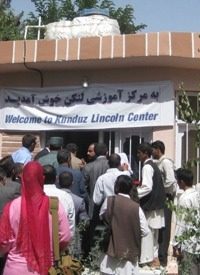
With the completion of a new Tourist Information Center in the isolated Bamiyan Valley, local officials, residents, foreign donors, and a handful of international aid agencies are hoping to attract visitors and their money to the area.
The central province has long been considered one of the safest in Afghanistan, but the eight-hour drive over dirt roads and the land mines — not to mention the fighting currently ravishing the nation — could likely deter all but the most intrepid explorers.
“Afghanistan is definitely a good brand. People will come…. They go to Nepal this year, they go to Chile the next year, they’re off to Afghanistan if it’s accessible,” said Andrew Scanlon, an expert on protected areas who is organizing a half-marathon through the region in September. He explained to the Associated Press that the plan is “providing really really fantastic outdoor experiences in natural landscapes that are somehow managed so it doesn’t get out of control.”
At the tourism center, about 20 local residents gather every day to learn how to become tour guides. Other locals are training to operate hotels, restaurants and other facilities that will cater to the tourists they hope will arrive someday soon.
As part of a $1.2 million “eco-tourism” program, the efforts in the region are funded in large measure by the Aga Khan Development Network, an Islamic charity based in Geneva. Other big donors in the area include Japan and New Zealand, which has a military unit helping with development there. Currently all initiatives to attract visitors are funded by foreigners, according to the deputy minister for tourism.
According to an Associated Press article entitled “Looking for vacation? Try Afghanistan,” visitors to the area have increased, if only by a few hundred. A representative of the information and culture ministry said hotel and airport records indicate that about 400 foreigners had been there by June of this year, up from 180 at the same time last year. By October the major historical sights are set to be free of the dangerous land mines that have kept many tourists at bay — and it would seem that there is plenty to see in the region.
In 2001, many Americans got a glimpse of the area in a film of the Taliban destroying gigantic ancient Buddha statues carved into the jagged cliff sides. Ancient cities and stunning natural beauty are also expected to lure history aficionados and nature lovers alike. In fact, the region was popular with American hippies on “enlightenment” journeys several decades ago.
Another recent initiative to attract tourists to the war-torn nation was undertaken by some Afghans in the Northeastern province of Badakshan — in the remote Hindu Kush mountain range. According to a July 24 article in the Khaleej Times, an Afghan farmer, a mason, and a teacher decided to become the first Afghans to summit Noshaq, one of the highest peaks in the world. Their mission was to promote peace and encourage tourists and adventure seekers to return once more to the region that used to attract travelers from around the world.
Some adventure-seeking tourists do still visit the country — especially northern areas that are more accessible due to borders with countries like Tajikistan. A 44-year-old German doctor named Peter Schneider who recently visited the region with a tour company told the Associated Press, “It’s some sort of adventurous traveling, so it’s of course more interesting than going to Thailand. Which is actually quite boring, isn’t it?” He also said he hopes to return when safety improves to visit Kabul and other areas of Afghanistan. A quick perusal of Google reveals a myriad of tourism companies that are still operating throughout the country.
Even though it may be possible to visit, many countries warn their citizens to avoid the war-ravished nation. The U.S. travel warning states: “No part of Afghanistan should be considered immune from violence, and the potential exists throughout the country for hostile acts, either targeted or random, against American and other Western nationals at any time.”
While it would certainly be interesting to visit an area so distinct from everything Americans are accustomed to, it would probably be best to wait until some semblance of security returns. When that might be is anybody’s guess. But for real thrill seekers who don’t mind taking extreme risks, it would certainly be quite an adventure to explore and understand a culture and people so isolated from the modern world.



